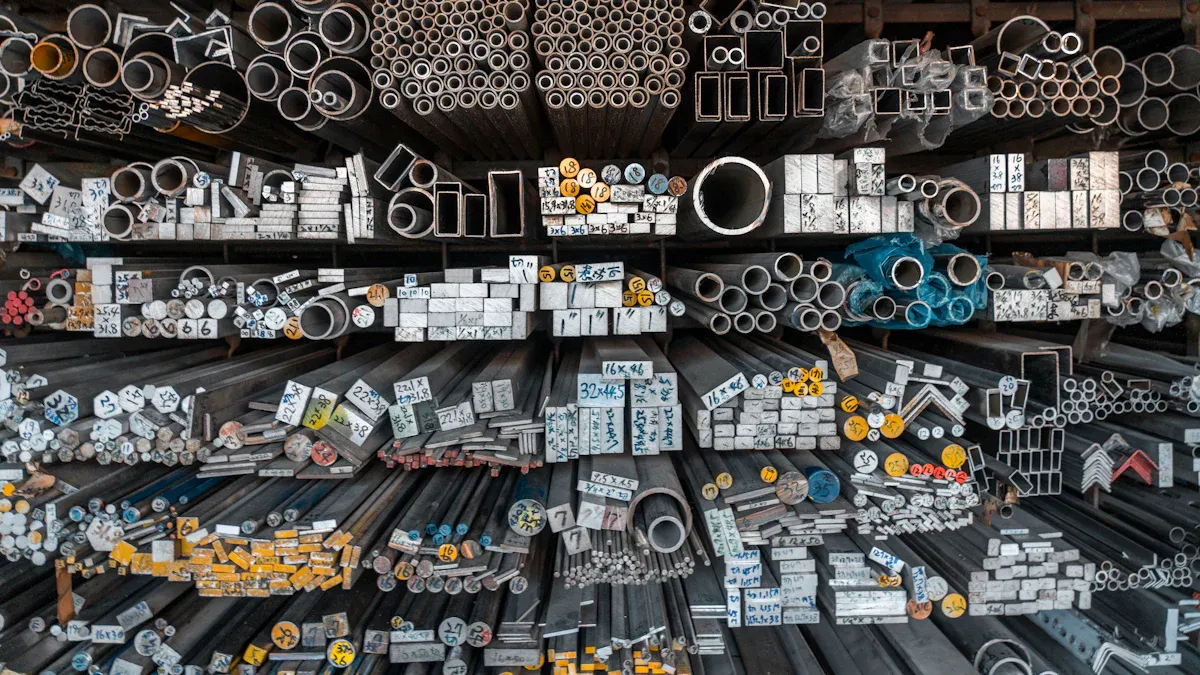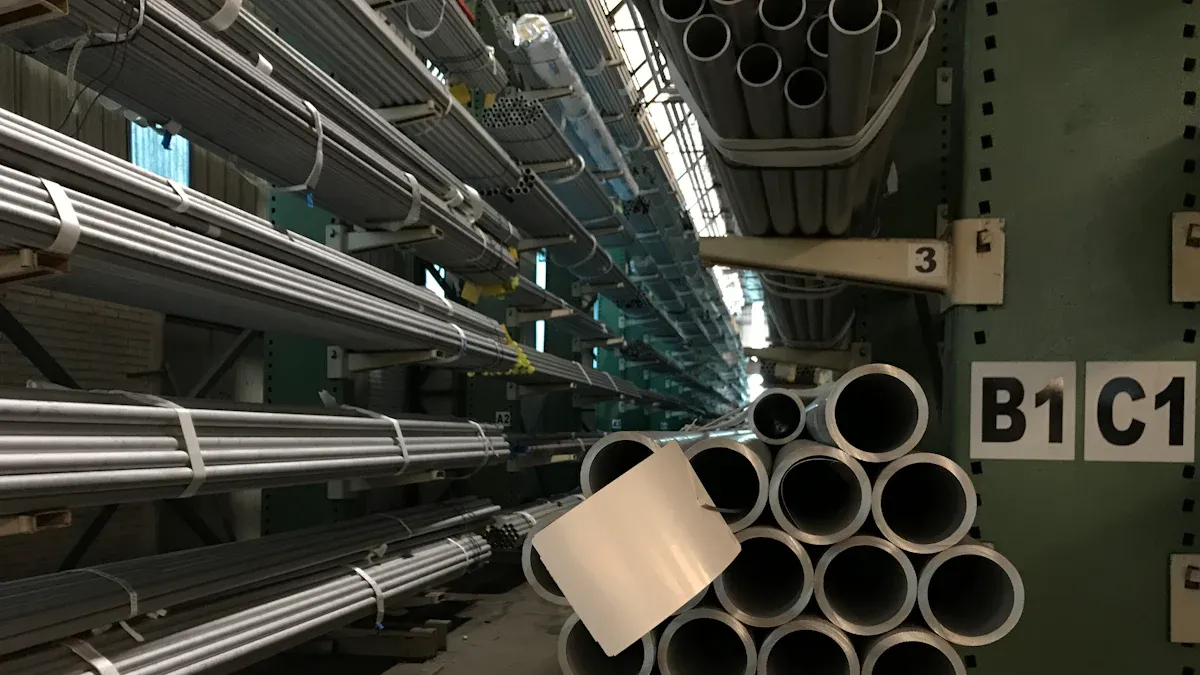How Thin-Wall Nitinol Tubing Is Made for Microcatheter Use

Manufacturing thin-wall nitinol tubing for microcatheter applications demands exceptional precision. Engineers prepare nitinol, an alloy of nickel and titanium, with exacting control over composition. Advanced techniques shape the material into ultra-thin tubes, ensuring uniform wall thickness. Heat treatment enhances its unique properties, such as shape memory and superelasticity. Every step of the process guarantees biocompatibility and durability, making the tubing suitable for intricate medical procedures. Uniformity in dimensions and surface quality remains critical to achieving reliable performance in microcatheters.
Key Takeaways
Nitinol has special traits like shape memory and flexibility. These make it great for microcatheters to move through tricky blood vessels safely.
Controlling wall thickness during making is very important. High-tech imaging tools check thickness instantly to keep it even and working well.
Polishing the surface makes nitinol tubing smoother and safer for the body. This lowers friction and prevents harm to tissues during surgeries.
Checking quality is key when making nitinol tubing. Careful tests make sure it meets medical rules, staying safe and dependable.
New ways of making nitinol, like using machines and better materials, cut costs but keep the tubing high-quality for medical use.
Properties of Nitinol for Microcatheter Applications
Shape memory and superelasticity
Nitinol's shape memory and superelasticity make it an ideal material for microcatheter applications. Shape memory allows nitinol to return to its original form after deformation when exposed to a specific temperature. Superelasticity enables the material to endure significant strain without permanent deformation, ensuring durability during medical procedures. Flexibility tests, such as the three-point bending test (ASTM F2606-08), demonstrate nitinol's superior performance. For example:
Solitaire FR stents required only 0.38 ± 0.11 N of force, showcasing their high flexibility.
Trevo XP ProVue stents needed 0.91 ± 0.11 N, indicating lower flexibility compared to Solitaire FR.
These properties ensure that thin walled tubes made from nitinol can adapt to complex vascular pathways without compromising structural integrity.
Biocompatibility and corrosion resistance
Biocompatibility is critical for materials used in high-performance catheters. Nitinol's nickel-titanium composition offers excellent resistance to corrosion, even in challenging in vivo environments. Research by Eiselstein et al. (2009) highlights the importance of surface finishing in enhancing nitinol's corrosion resistance. This ensures that nitinol remains safe for prolonged use in the human body. Additionally, its biocompatibility minimizes the risk of adverse reactions, making it a trusted choice for medical-grade devices.
Flexibility and kink resistance in thin-wall designs
Thin walled tubes made from nitinol exhibit exceptional flexibility and kink resistance, crucial for navigating intricate vascular systems. The FDA guidance document no. 1545 emphasizes the importance of kink resistance in stents, requiring them to withstand bending without lumen loss exceeding 50%. Testing protocols, such as those conducted in a 37°C water bath, assess the smallest radius of curvature that nitinol tubing can endure without kinking. These tests confirm that nitinol tubing maintains its original shape and size after bending, ensuring reliable performance in high-performance catheters.

Manufacturing Thin-Wall Nitinol Tubing for Microcatheter Applications

Material preparation and alloy composition
The manufacturing process begins with the careful preparation of nitinol, an alloy of nickel and titanium. Engineers maintain a precise ratio of these two elements, typically around 55% nickel and 45% titanium by weight. This specific composition ensures the alloy exhibits its unique properties, such as shape memory and superelasticity.
Purity plays a critical role in the performance of thin-wall nitinol tubing for microcatheter applications. Impurities, even in trace amounts, can compromise the material's biocompatibility and mechanical properties. To address this, manufacturers source high-grade raw materials and use advanced refining techniques to eliminate contaminants.
Vacuum induction melting (VIM) is a common method used to produce nitinol ingots. This process involves melting the alloy in a vacuum environment to prevent oxidation and ensure uniformity. Once the ingots are prepared, they undergo further processing to achieve the desired microstructure and mechanical properties.
Extrusion techniques for forming thin-wall tubing
Extrusion is a critical step in shaping nitinol into thin-wall tubing. The extrusion process involves forcing the alloy through a die to create a hollow tube with precise dimensions. This technique ensures the tubing meets the stringent requirements of microcatheter applications, such as uniform wall thickness and smooth inner and outer surfaces.
Several parameters influence the outcome of the extrusion process. These include air pressure, screw speed, and puller speed. Adjusting these parameters allows manufacturers to control the tube's size, wall thickness, and overall quality. The table below highlights the effects of these parameters on the final product:
Parameter | Effect on Tube Size |
|---|---|
Air Pressure | Increases inner and outer diameter; improves ovality |
Screw Speed | Most significant effect on inner and outer diameters |
Puller Speed | Affects tube size similarly to screw speed |
Wall Thickness | Slightly reduced with increased air pressure |
Tolerance | Inner diameter and outer diameter tolerance ±20 µm |
Wall Thickness Tolerance | Does not exceed ±15 µm |
The extrusion process also incorporates advanced imaging techniques to monitor tube dimensions in real time. These systems detect any deviations from the desired specifications, ensuring consistent quality throughout production.
Heat treatment and shape-setting processes
After extrusion, the tubing undergoes heat treatment to enhance its mechanical properties and set its final shape. Heat treatment involves heating the nitinol tubing to a specific temperature and then cooling it under controlled conditions. This process refines the alloy's microstructure, improving its flexibility, superelasticity, and fatigue resistance.
Shape-setting is another crucial step in this stage. Manufacturers use specialized fixtures to hold the tubing in the desired configuration during heat treatment. This ensures the tubing retains its shape memory properties, allowing it to return to its original form after deformation.
For thin-wall nitinol tubing for microcatheter applications, maintaining precise control over the heat treatment process is essential. Variations in temperature or cooling rates can lead to inconsistencies in the tubing's performance. To prevent this, manufacturers use computer-controlled furnaces and thermal imaging systems to monitor the process.
Surface finishing for smoothness and precision
Surface finishing plays a vital role in ensuring the performance and reliability of thin-wall nitinol tubing for microcatheter applications. A smooth and precise surface minimizes friction, reduces the risk of tissue damage, and enhances the tubing's biocompatibility. Manufacturers employ various techniques to achieve the desired surface quality, each tailored to meet specific medical-grade requirements.
The table below highlights common surface finishing methods and their corresponding surface finish measurements:
Technique | Surface Finish (µin Ra) | Notes |
|---|---|---|
Abrasive Cutting | 32 or 63 | Depending on the wheel used |
Lapping | 16 | Achieves smoother finishes |
Mechanical Polishing | 1 or better | Best results for end cuts |
Grinding | 8 to 16 | Achievable under certain circumstances |
Tumble Deburring | 8 or better | Creates polishing action |
Sandblasting/Grinding | >100 | For intentionally rough surfaces |
Mechanical polishing is often the preferred method for achieving ultra-smooth finishes, particularly for end cuts. This technique ensures the tubing meets stringent medical standards by reducing surface irregularities to less than 1 µin Ra. Grinding and lapping are also widely used, offering a balance between precision and cost-efficiency. For applications requiring intentionally rough surfaces, sandblasting or grinding may be employed.
Advanced imaging systems monitor the surface quality during finishing processes. These systems detect imperfections in real time, allowing manufacturers to make adjustments and maintain consistency. By combining precise techniques with continuous monitoring, manufacturers ensure that the tubing meets the high standards required for microcatheter applications.
Quality control to meet medical-grade standards
Quality control is a cornerstone of manufacturing thin-wall nitinol tubing for microcatheter applications. Medical devices must comply with rigorous standards, including ISO 13485 and FDA 21 CFR Part 820. These regulations ensure that the tubing is safe, reliable, and suitable for use in critical medical procedures.
Each batch of tubing undergoes extensive testing to verify its performance. Key tests include:
Radial force testing to measure the tubing's ability to withstand external pressures.
Fatigue resistance testing to ensure durability under repeated stress.
Biocompatibility assessments to confirm the material's safety for prolonged use in the human body.
Despite these measures, failure rates during trials average between 12% and 15%. Rework cycles, often necessary to address defects, can delay shipments by 20 to 30 days. In 2023, a leading European manufacturer reported a 22% increase in compliance costs due to enhanced sterilization protocols. These challenges underscore the importance of robust quality control systems.
Manufacturers increasingly rely on automated inspection technologies to improve efficiency and accuracy. AI-driven systems analyze tubing dimensions, surface quality, and mechanical properties in real time. These systems reduce human error and help identify defects early in the production process. By integrating advanced technologies, manufacturers can meet the stringent requirements of medical-grade nitinol tubing while minimizing delays and costs.
Challenges in Manufacturing Thin-Wall Nitinol Tubing
Achieving ultra-thin walls with uniform thickness
Producing thin walled tubes with consistent wall thickness presents a significant challenge. The process requires precise control over material flow during extrusion and subsequent processing. Even minor deviations can lead to inconsistencies, which may compromise the tubing's performance in high-performance catheters.
To address this, manufacturers use advanced imaging systems to monitor wall thickness in real time. These systems detect variations as small as ±5 µm, enabling immediate adjustments. Additionally, engineers optimize extrusion parameters, such as air pressure and puller speed, to achieve uniformity. Despite these efforts, achieving ultra-thin walls without defects remains a complex task, especially for tubing with diameters below 0.5 mm.
Preventing material fatigue and ensuring durability
Thin walled tubes must withstand repeated stress during use in medical procedures. Material fatigue, caused by cyclic loading, poses a significant risk to their durability. Manufacturers mitigate this by carefully controlling the alloy's microstructure through heat treatment and cold working.
Empirical data highlights the relationship between cold work levels and fatigue resistance. For example:
Mean Cycles to Failure | Testing Conditions | |
|---|---|---|
20 | Highest | Strain-controlled fatigue testing at 10°C above A_f |
30 | High | Strain-controlled fatigue testing at 10°C above A_f |
55 | Lower | Strain-controlled fatigue testing at 10°C above A_f |
The data shows that lower cold work levels improve fatigue resistance, making the tubing more durable. Additionally, loading conditions, such as torsion and multiaxial stresses, significantly impact fatigue behavior:
Loading Condition | Effect on Fatigue Behavior |
|---|---|
Torsion | Investigated for fatigue life behavior |
Multiaxial | Critical for predicting safe lifetime under physiological conditions |
By understanding these factors, manufacturers can optimize production processes to enhance the durability of thin walled tubes.
Addressing bending stresses and rotational stability
Thin walled tubes used in high-performance catheters must endure bending stresses and maintain rotational stability. These properties are essential for navigating complex vascular pathways without compromising performance. However, achieving this balance is challenging due to the tubing's ultra-thin walls.
Engineers address this by refining the alloy's composition and microstructure. Heat treatment processes, such as shape-setting, improve the tubing's ability to recover its original shape after bending. Additionally, manufacturers conduct rigorous testing to evaluate bending performance. For instance, tests measure the smallest radius of curvature the tubing can withstand without kinking or losing structural integrity.
Rotational stability is another critical factor. Thin walled tubes must resist twisting forces during use. To ensure this, manufacturers optimize the tubing's geometry and surface finish. Smooth surfaces reduce friction, while precise dimensions enhance stability. These measures help the tubing perform reliably under demanding conditions.
Meeting stringent regulatory and biocompatibility requirements
Manufacturing thin-wall nitinol tubing for microcatheter applications requires strict adherence to regulatory standards and biocompatibility guidelines. These measures ensure the tubing is safe, reliable, and suitable for use in medical procedures. Regulatory certifications, such as ISO 9001:2015, ISO 13485:2016, and EU CE marking, validate the quality of the tubing. They confirm that the manufacturing process meets industry standards and minimizes risks of adverse biological reactions, such as cytotoxicity or irritation.
Note: Compliance with these certifications is not optional. It is a mandatory step to ensure the tubing can be used in life-saving medical devices.
Biocompatibility testing plays a critical role in evaluating the tubing's safety. These tests assess how the material interacts with human tissues and fluids. For instance, histological evaluations often reveal minimal tissue reactions post-implantation. Scores for these reactions typically range from 0 to 1, indicating excellent compatibility. Additionally, no significant inflammatory responses, such as the presence of polymorphonuclear leukocytes, plasma cells, or necrosis, are observed in most cases.
Evidence Type | Description |
|---|---|
Tissue Reactions | Minimal tissue reactions post-implantation, with scores ranging from 0 to 1. |
Histological Findings | No significant inflammatory responses; no necrosis or harmful cell activity. |
Regulatory compliance also involves monitoring key manufacturing parameters. Temperature and pressure are carefully controlled during production to maintain material integrity and ensure safety. Specific alloy ratios are used to enhance biocompatibility, ensuring the tubing performs reliably under operational conditions.
Compliance Metrics | Details |
|---|---|
Temperature | Monitored during manufacturing to ensure safety and efficacy. |
Pressure | Assessed to validate material integrity under operational conditions. |
Material Composition | Specific alloy ratios to ensure biocompatibility. |
Manufacturers must document every step of the production process to meet these stringent requirements. This documentation includes detailed records of material composition, process parameters, and test results. Regulatory bodies, such as the FDA and European Medicines Agency (EMA), review these records to grant approval for medical use.
By meeting these rigorous standards, manufacturers ensure that thin-wall nitinol tubing remains safe and effective for microcatheter applications. This commitment to quality and safety underscores the tubing's critical role in advancing modern medical technology.
Innovations in Thin-Wall Nitinol Tubing Manufacturing

Advances in extrusion and microfabrication techniques
Recent advancements in extrusion and microfabrication techniques have revolutionized the production of thin-wall nitinol tubing. These innovations enable manufacturers to achieve greater precision and efficiency, meeting the stringent requirements of medical applications. Extrusion processes now incorporate advanced imaging systems that monitor tube dimensions in real time, ensuring uniform wall thickness and smooth surfaces.
Technical studies highlight the progress in microfabrication methods. For example, Shayan et al. (2016) explored micropatterned thin film nitinol for embolic protection stents. Shin et al. (2005) demonstrated the use of sacrificial layers to fabricate thin film NiTi thermostat arrays. Yip et al. (2023) introduced rapid shaping techniques for low-cost prototyping, while Alaie et al. (2020) focused on patient-specific occluders using advanced manufacturing methods. Obeidi et al. (2021) investigated laser beam powder bed fusion for direct 3D printing of nitinol.
Study/Report | Focus | Findings |
|---|---|---|
Shayan et al. (2016) | Micropatterned thin film nitinol | Suggested use in stents for embolic protection. |
Shin et al. (2005) | Thin film NiTi thermostat arrays | Demonstrated fabrication using sacrificial layers. |
Yip et al. (2023) | Low-cost prototyping | Introduced rapid shaping techniques for nitinol. |
Alaie et al. (2020) | Patient-specific occluders | Advanced manufacturing techniques for implants. |
Obeidi et al. (2021) | Laser beam powder bed fusion | Explored direct 3D printing of nitinol. |
These studies underscore the importance of combining extrusion with microfabrication to produce high-quality nitinol tubing for microcatheter applications.
AI-driven quality control and defect detection
Artificial intelligence (AI) has transformed quality control in nitinol tubing manufacturing. AI-driven systems analyze tubing dimensions, surface quality, and mechanical properties in real time. These systems detect defects early, reducing human error and improving production efficiency.
Machine learning algorithms identify patterns in manufacturing data, enabling predictive maintenance and process optimization. For example, AI systems can adjust extrusion parameters to maintain consistent wall thickness. This ensures that the tubing meets medical-grade standards while minimizing waste and production delays.
AI also enhances defect detection during microfabrication. Advanced imaging technologies, integrated with AI, capture high-resolution images of the tubing's surface. These systems identify imperfections, such as microcracks or irregularities, that could compromise performance. By leveraging AI, manufacturers achieve higher accuracy and reliability in producing thin-wall nitinol tubing.
Development of enhanced alloys and coatings
Innovations in alloy composition and coating applications have significantly improved the performance of thin-wall nitinol tubing. Manufacturers now alter the ratio of nickel and titanium to enhance the material's properties. Alloying with ternary elements expands the operational temperature range and improves fatigue resistance, which is crucial for medical devices.
New coatings further enhance the tubing's biocompatibility and corrosion resistance. These coatings reduce friction, ensuring smooth navigation through vascular pathways. Additionally, they protect the tubing from wear and tear, extending its lifespan.
Recent advancements in processing techniques have refined the microstructure of nitinol alloys. These methods improve flexibility and durability, making the tubing suitable for complex medical procedures. By combining enhanced alloys with advanced coatings, manufacturers produce tubing that meets the highest standards of safety and performance.
Cost-efficient production methods for medical applications
Manufacturers of thin-wall nitinol tubing for microcatheter applications face the challenge of balancing cost efficiency with stringent quality standards. Several innovative methods help reduce production costs without compromising performance or safety.
Automation in Manufacturing
Automation plays a key role in reducing labor costs and improving production speed. Robotic systems handle repetitive tasks, such as extrusion and surface finishing, with high precision. Automated quality control systems, powered by AI, detect defects early in the process. This minimizes waste and reduces the need for rework. For example, AI-driven imaging systems can identify wall thickness variations in real time, ensuring consistent quality while lowering operational costs.Material Optimization
Optimizing material usage is another effective cost-saving strategy. Manufacturers carefully calculate the amount of nitinol required for each batch, reducing waste during production. Advanced recycling techniques allow the reuse of excess material, further cutting costs. Additionally, alloy modifications, such as incorporating ternary elements, enhance performance while using less raw material.Streamlined Production Processes
Streamlining production steps improves efficiency and reduces energy consumption. Techniques like near-net-shape extrusion minimize the need for extensive post-processing. Heat treatment processes, optimized for energy efficiency, lower operational expenses. Manufacturers also adopt lean manufacturing principles to eliminate unnecessary steps and improve workflow.
Tip: Collaborative partnerships with suppliers can also reduce costs. Bulk purchasing of raw materials often results in significant savings.
Scalable Production Techniques
Scaling production for high-demand applications lowers per-unit costs. Manufacturers invest in modular equipment that can adapt to varying production volumes. This flexibility ensures cost efficiency, even for small-batch orders.
By combining these methods, manufacturers produce high-quality thin-wall nitinol tubing at a lower cost. These innovations make advanced medical devices more accessible, benefiting both healthcare providers and patients.
Manufacturing thin-wall nitinol tubing for microcatheter applications involves several precise steps. These include material preparation, wire shaping, micro-grinding, heat treatment, and surface finishing. Each stage ensures the tubing meets stringent medical standards. For example:
Material preparation achieves the desired alloy properties.
Heat treatment optimizes shape memory and superelasticity.
Surface finishing enhances biocompatibility and corrosion resistance.
Performance Metric | Description |
|---|---|
Wall Thickness Tolerance | Controlled within 0.01 mm for uniformity. |
Surface Roughness | Achieved roughness (Ra) ≤0.1 μm for improved corrosion resistance. |
Mechanical Stability | Maintains performance after 20 cycles of 6% strain recovery testing. |
Precision and innovation drive advancements in this field. Leading manufacturers invest in research to refine alloy compositions and improve production techniques. Enhanced quality control ensures reliable performance, while strategic collaborations expand technological capabilities. These efforts make thin-wall nitinol tubing indispensable in advancing microcatheter technology, enabling safer and more effective medical procedures.
FAQ
What makes nitinol ideal for microcatheter applications?
Nitinol's unique properties, such as shape memory, superelasticity, and biocompatibility, make it ideal for microcatheters. These features allow the tubing to navigate complex vascular pathways while maintaining durability and flexibility. Its corrosion resistance further ensures safety during prolonged use in medical procedures.
How is wall thickness controlled during manufacturing?
Manufacturers use advanced imaging systems to monitor wall thickness in real time. These systems detect deviations as small as ±5 µm, enabling precise adjustments during extrusion. This ensures uniformity, which is critical for the tubing's performance in microcatheter applications.
Why is surface finishing important for nitinol tubing?
Surface finishing enhances the tubing's smoothness, reducing friction and minimizing tissue damage during use. It also improves biocompatibility and corrosion resistance, ensuring the tubing meets stringent medical-grade standards. Techniques like mechanical polishing achieve ultra-smooth finishes for optimal performance.
What challenges arise in producing ultra-thin nitinol tubing?
Producing ultra-thin tubing requires precise control over material flow and extrusion parameters. Minor deviations can lead to inconsistencies, compromising performance. Manufacturers address these challenges with advanced monitoring systems and optimized processes to achieve uniformity and durability.
How does heat treatment improve nitinol tubing?
Heat treatment refines nitinol's microstructure, enhancing its flexibility, fatigue resistance, and shape memory properties. Controlled heating and cooling processes ensure consistent performance, allowing the tubing to recover its original shape after deformation during medical procedures.
See Also
The Process Behind Nitinol Tubing Production for Healthcare
The Importance of Nitinol Tubing in Minimally Invasive Surgery
The Significance of Nitinol Tubing in Modern Medicine
Nitinol Tubing's Impact on the Future of Medical Devices
Nitinol Tubing's Contribution to Progress in Medical Technology

